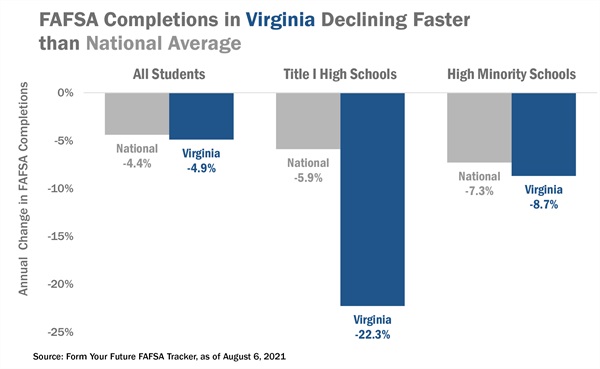Every year, over 25,000 students graduate from a Virginia high school but don’t enroll in some sort of college program within sixteen months. Only 54% of low-income students enroll in college or training, 15 points below the overall state rate of 69%. These disparities impede Virginia’s path to be the best state for education with 70% of its working-age population earning a degree or credential by 2030.
One way to increase the number of students enrolling is for students to complete the Free Application for Federal Student Assistance, or FAFSA. FAFSA completion is required to access thousands of dollars of federal and state aid, not to mention getting on the radar of potential institutions, which then send information to prospective students.
The National College Attainment Network’s Form Your Future tool empowers us to track FAFSA completion across the county. Compared to the rest of the nation, Virginia’s rates of FAFSA completion at middle of the pack. Last school year, 2020-21, just over 60% of high school seniors completed the FAFSA, ranking Virginia 24th in the nation. For a state wanting to be the best state for education, middle of the pack just isn’t good enough. Obviously the COVID-19 pandemic and shift to virtual instruction challenged school counselors and college access providers to help their students explore college options, apply for financial aid and choose a path after high school. But even with all of the challenges, Virginia’s FAFSA completions declined only slightly from the previous year (2018-19), when Virginia also ranked 24th in the nation in FAFSA completions.

In some areas Virginia's FAFSA completion numbers are more distressing, particularly in high schools with high concentrations of low-income students and racial minorities. Nationally, FAFSA completions are down 4.4% from this time last year; Virginia isn’t too far behind, with a 4.9% decline. Nationally at Title I schools, schools with high concentrations of low-income students, FAFSA completion is down 5.9%. Virginia’s Title I schools have seen a 22.3% decline, three times lower than the national average. Virginia’s high schools with high concentrations of racial minorities also are down more than the national average, which should serve as a wake up call for policymakers; Virginia’s low-income students already enroll in college at lower rates, and these data indicate they are likely to fall further behind.
Declining FAFSA completions could be an early indicator of declining enrollment for the fall. Last year, although enrollments in the four-year public sector remained relatively flat overall, they declined at roughly half of these institutions. Also, the number of undergraduates declined for the first time in at least 10 years. As for Virginia's Community Colleges, enrollment declined nearly 5%.
While these declines might be caused by the pandemic, more structural and long-term trends are at work. Free college programs and generous aid packages lure students to other states or convince them to stay in their home state (Virginia's free community college program, G3, was launched July 1 2021). Last but not least, the number of high school graduates is projected to decline in 2026, six years from now. Why six years from now? Because 2026 is 19 years after the Great Recession, which caused a decline in birthrates. Fewer babies lead to fewer high school graduates, which leads to fewer college enrollments.
The Takeaway
Recent acts of the General Assembly, as well as initiatives from the Governor’s Office and new funding and research partnerships, represent a growing interest for a more intentional and coordinated access strategy. For instance, Governor Northam and Secretary of Education Atif Qarni convened a work group tasked with forming long-term legislative and budgetary recommendations to improve Virginia’s FAFSA completion rates.
In 2021, Virginia’s General Assembly funded a new initiative at SCHEV focused on postsecondary access, dubbed Guidance to Postsecondary Success (GPS), the first time the Commonwealth has funded a statewide college access initiative. SCHEV plans to use these funds to support a shared position between VDOE and SCHEV dedicated to coordinating resources to help Virginians access education and training after high school. This interagency position reflects efforts to improve coordination and communication between SCHEV and VDOE, including developing shared definitions and accountability metrics.
SCHEV and VDOE also formed a partnership with the Virginia College Access Network (VirginiaCAN) to improve FAFSA completion rates in spring 2021 during the pandemic as many on-site events were cancelled. Together they launched a virtual one-on-one pilot platform that connected families and students with 50 trained college counselors, transcending issues such as asymmetrical capacity and the disruption of in-person school caused by the pandemic. The pilot program served over 250 families between March 15th and June 30th.
Improving Virginia’s FAFSA completions will require a sustained and coordinated effort combining of both statewide strategy and on-the-ground assistance. We are challenged by long-term demographic trends and disparate resources at the local level. We hope that recent initiatives will address those challenges and push those FAFSA numbers up.
